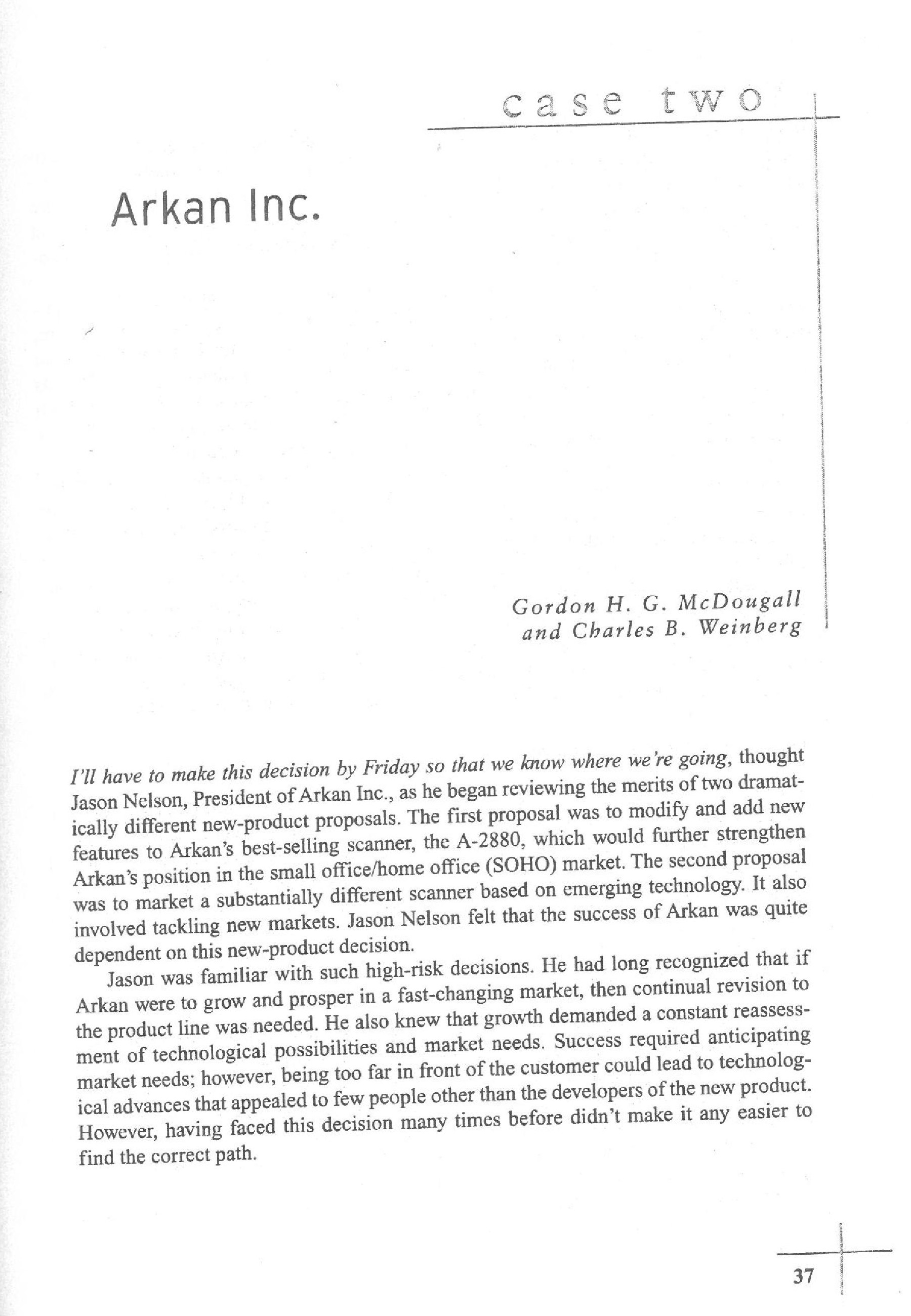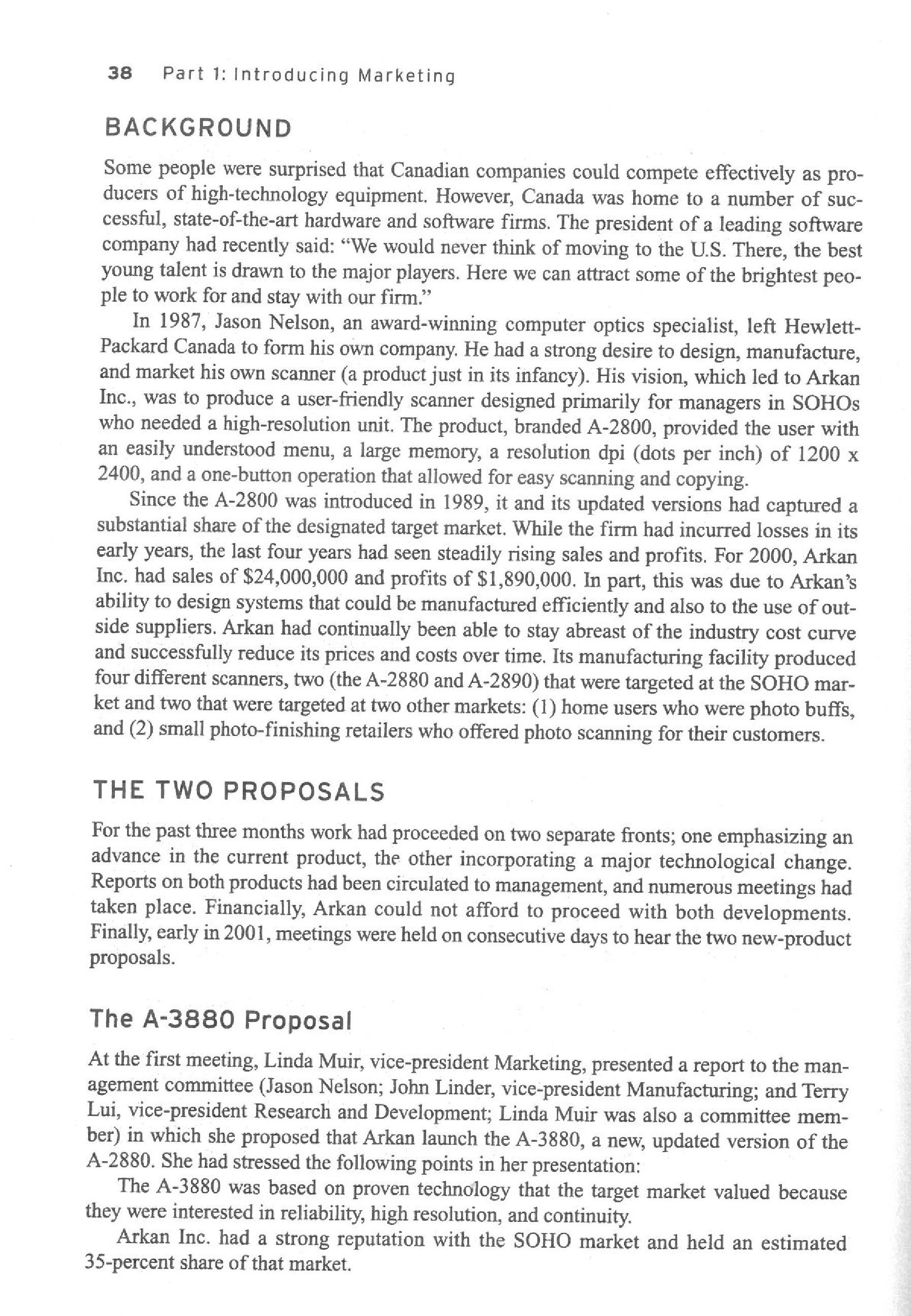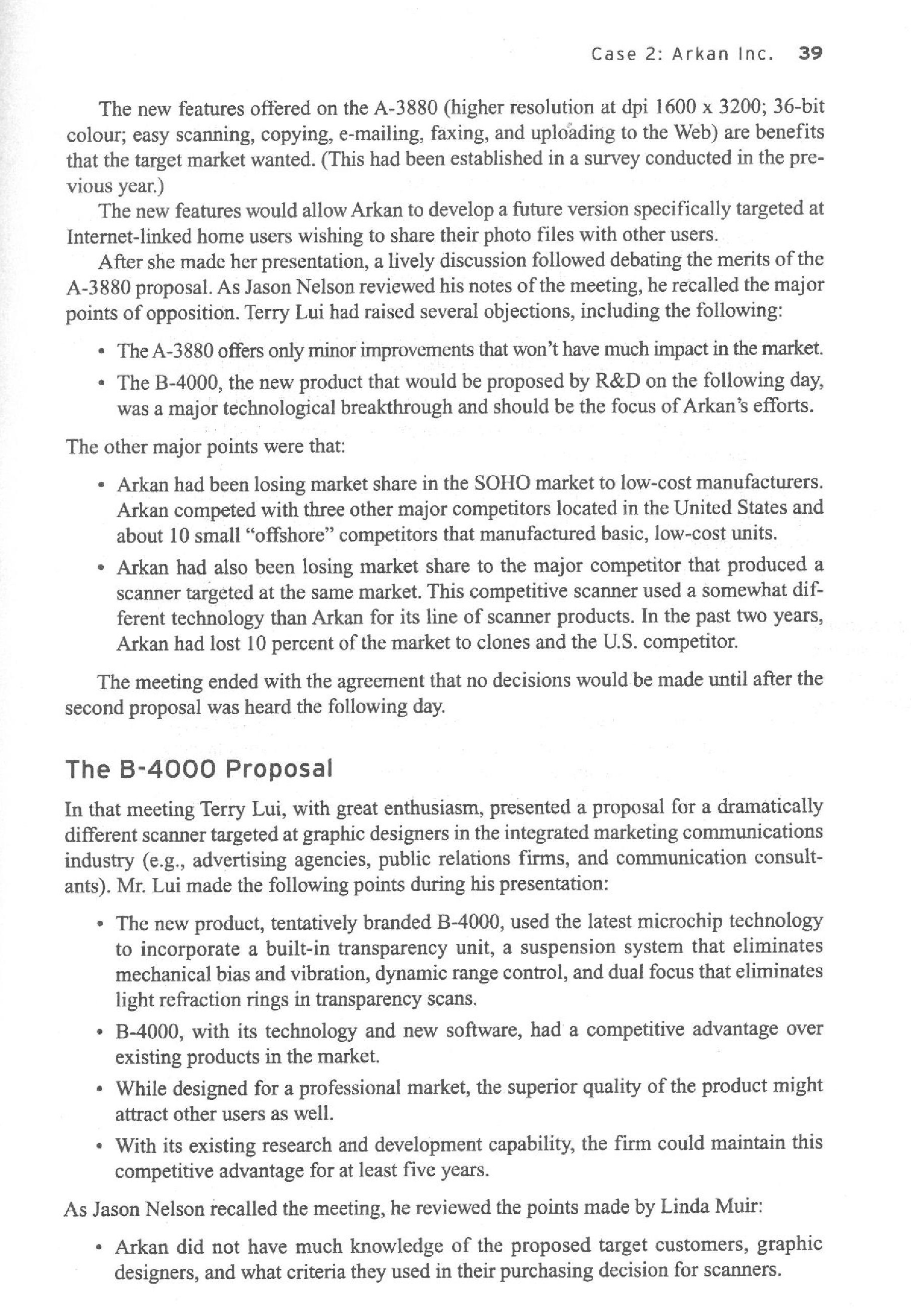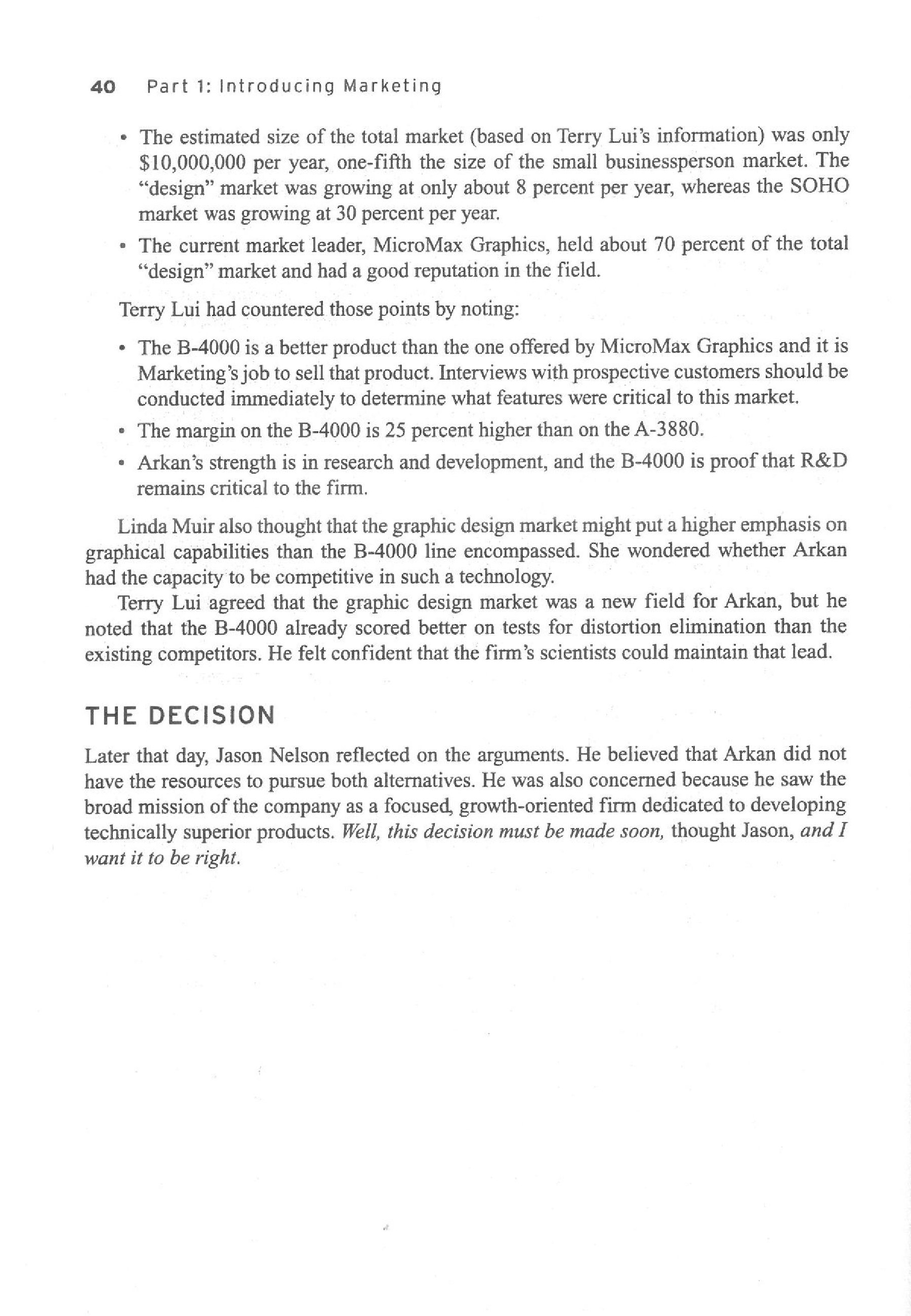I have a few questions bout the analysis of a case study. The case study is attached.
- What is the future sale revenue and profit for 4 years for the two mentioned alternatives (A-3880 and B-4000)?
- How can I calculate the margins and profitability for 4 years for the two mentioned alternatives (A-3880 and B-4000)?
- What is them Market share for the two mentioned alternatives (A-3880 and B-4000)?
- What is the market size for the two mentioned alternatives (A-3880 and B-4000)?
- How can I calculate the growth in the market for the two mentioned alternatives (A-3880 and B-4000)?
ease two N Arkan Inc. Gordon H. G. McDongaH and Charles B. Weinberg I'll have to make this decision by Friday so that we know where we're going, thought Jason Nelson, President of Arkan Inc., as he began reviewing the merits of two dramat- ically different new-product proposals. The first proposal was to modify and add new features to Arkan's bestselling scanner, the A-2380, which would further strengthen Arkan's position in the small office/home office (SOHO) market. The second proposal Was to market a substantially different scanner based on emerging technology. It also invoived tackling new markets. Jason Nelson felt that the success of Arkan was quite dependent on this new-product decision. Jason was familiar with such highrisk decisions. He had long recognized that if Arkan were to grow and prosper in a fast'changing market, then continual revision to the product line was needed. He also knew that growth demanded a constant reassess ment of technological possibilities and market needs. Success required anticipating market needs; however, being too far in front of the customer could lead to technolog- ical advances that appealed to few people other than the developers of the new product. However, having faced this decision many times before didn't make it any easier to find the correct path. 1 L g 5 t i i l i l E 5 3 2 i i :15 i l l... ruinW 38 Part 1: Introducing Marketing BACKGROUND Some people were surprised that Canadian companies could compete effectively as pro ducers of highttechnology equipment. However, Canada was home to a number of suc- cessful, state-of-the-art hardware and soware firms. The president of a leading software company had recently said: \"We would never think of moving to the US. There, the best young talent is drawn to the major players. Here we can attract some of the brightest peo- ple to work fer and stay with our rm.\" In 1987, Jason Nelson, an award-winning computer optics specialist, left Hewlett- Packard Canada to form his own company. He had a strong desire to design, manufacture, and market his own scanner (a product just in its infancy). His vision, which led to Arkan Inc., was to produce a user-friendly scanner designed primarily for managers in SOHOs who needed a high-resolution unit. The product, branded A2800, provided the user with an easily understood menu, a large memory, a resolution dpi (dots per inch) of 1200 x 2.400, and a one~button operation that allowed for easy scanning and copying. Since the [Ir-2800 was introduced in i989, it and its Updated versions had captured a substantial share of the designated target market. While the firm had incurred losses in its early years, the last four years had seen steadily rising sales and prots. For 2000, Arkan Inc. had sales of $24,000,000 and profits of $1,890,000. In part, this was due to Arkan's ability to design systems that could be manufactured efficiently and also to the use of out- side suppliers. Arkan had continually been able to stay abreast of the industry cost curve and \"successfully reduce its prices and costs over time. Its manufacturing facility produced four different scanners, two (the A-2880 and A2890) that were targeted at the SOHO mar- ket and two that were targeted at two other markets: (1) home users who were photo buffs, and (2) small photo-finishing retailers who offered photo scanning for their customers. THE TWO PROPOSALS For the past three months work had proceeded on two separate fronts; one emphasizing an advance in the current pro-duct, the other incorporating a major technological change. Reports on both products had been circulated to management, and numerous meetings had taken place. Financially, Arkan could not afford to proceed with both developments. Finally, early in 2001, meetings were held on consecutive days to hear the two new-product proposals. The A-3880 Preposal At the rst meeting, Linda Muir, vice-president Marketing, presented a report to the man- agement committee (Jason Nelson; John Linder, vicepresident Manufacturing; and Terry Lui, vice-president Research and Development; Linda Muir was also a committee mem- ber) in which she proposed that Arkan launch the A3880, a new, updated version of the A-2880. She had stressed the following points in her presentation: The A-3880 Was based on proven technology that the target market valued because they were interested in reliability, high resolution, and continuity. Arkan Inc. had a strong reputation with the SOHO market and held an estimated 35-percent share of that market. Case 2: Arkan lnc. 39 The new features offered on the A-3 880 (higher resolution at dpi 1600 x 3200; 36-bit colour; easy scanning, copying, e-mailing, faxing, and uploading to the Web) are benefits that the target market wanted. (T his had been established in a survey conducted in the pre- vious year.) The new features would allow Arkan to develop a future version specifically targeted at interact-linked home users wishing to share their photo files with other users. After she made her presentation, a lively discussion followed debating the merits of the A3880 proposal. As Jason Nelson reviewed his notes of the meeting, he recalled the major points of opposition. Terry Lui had raised several objections, including the following: - The A-3880 o'ers only minor improvements that won't have much impact in the market. 0 The 3-4000, the new product that would be proposed by 11'.er on the following day, was a major technological breakthrough and should be the focus of Arkan's efforts. The other major points were that: - Arkan had been losing market share in the SOHO market to low-cost manufacturers. Arkan competed with three other major competitors located in the United States and about 10 small \"o'shore\" competitors that manufactured basic, lowcost units. - Arkan had also been losing market share to the major competitor that produced a scanner targeted at the same market. This competitive scanner used a somewhat dif~ ferent technology than Arkan for its line of scanner products. In the past two years, Arkan had lost 10 percent of the market to clones and the US. competitor. The meeting ended with the agreement that no decisions would be made until after the second proposal was heard the following day. The 3-4000 Proposal In that meeting Terry Lui, with great enthusiasm, pretreated a proposal for a dramatically different scanner targeted at graphic designers in the integrated marketing communications industry (cg, advertising agencies, public relations rms, and communication consult- ants). Mr. Lui made the following points during his presentation: - The new product, tentatively branded 34000, used the latest microchip technology to incorporate a built-in transparency unit, a suspension system that eliminates mechanical bias and vibration, dynamic range control, and dual focus that eliminates light refraction rings in transparency scans. ' B4000, with its technology and new software, had\" a competitive advantage over existing products in the market. ' While designed for a professional market, the superior quality of the product might attract other users as well. - With its existing research and development capability, the firm could maintain this competitive advantage for at least five years. As Jason Nelson recalled the meeting, he reviewed the points made by Linda Muir: - Arkan did not have much knowledge of the proposed target customers, graphic designers, and what criteria they used in their purchasing decision for scanners. 40 Part]: Introducing Marketing - The estimated size of the total market (based on Terry Lui's information) was only $10,000,000 per year, onefifth the size of the small husinessperson market. The \"design\" market was growing at only about 8 percent per year, whereas the SOHO market was growing at 30 percent per year. - The current market leader, MicroMax Graphics, held about 70 percent of the total \"design\" market and had a good reputation in the field. Terry Lui had countered, those points by noting: - The 3-4000 is a better product than the one offered by MicroMax Graphics and it is Marketing '5 job to sell that product. Interviews with prospective customers should be conducted immediately to determine what features were critical to this market. - The margin on the 13-4000 is 25 percent higher than on the A-3880. - Arkan's strength is in research and development, and the B4000 is proof that REL]? remains critical to the rm. Linda Muir also thought that the graphic design market might put a higher emphasis on graphical capabilities than the 3-4000 line encompassed. She wondered whether Arkan had the capacity'to be competitive in such a technology. ' Terry Lui agreed that the graphic design market was a new eld for Arkan, but he noted that the B4000 already scored better on tests for distortion elimination than the existing competitors. He felt confident that the firm's scientists could maintain that lead. THE DECISiON Later that day, Jason Nelson reected on the arguments. He believed that Arkan did not have the resources to pursue both alternatives. He was also concerned because he saw the broad mission of the company as a focused, growth-oriented firm dedicated to developing technicality superior products. Well, this decision must be made soon, thought Jason, and I want it to be right










